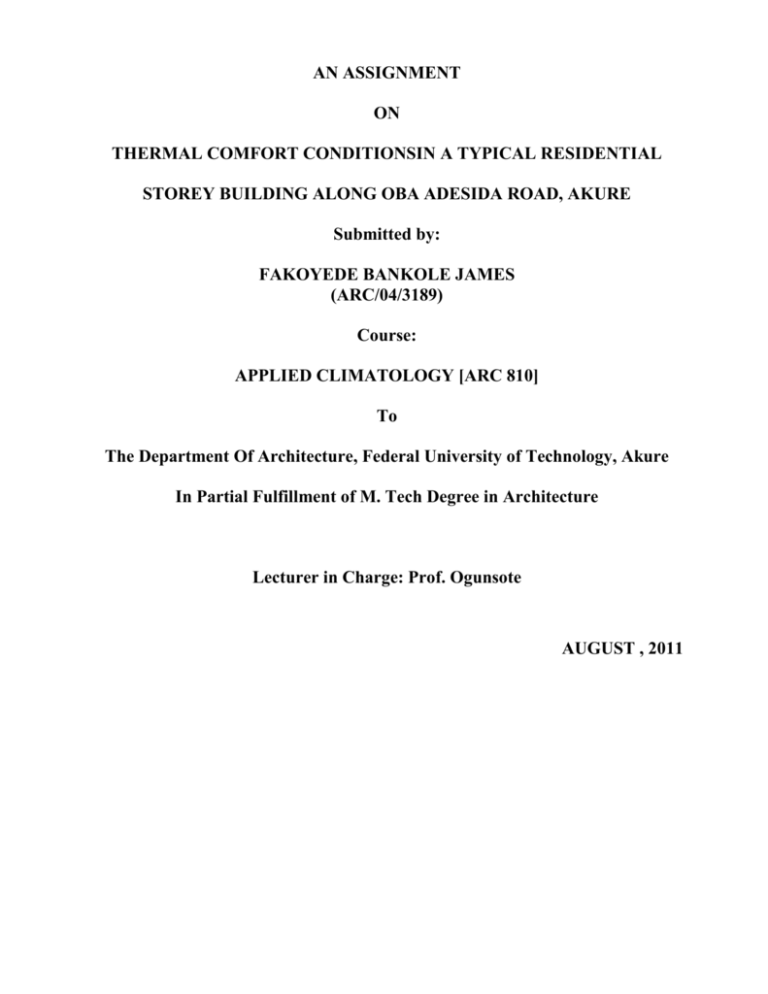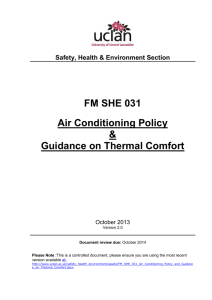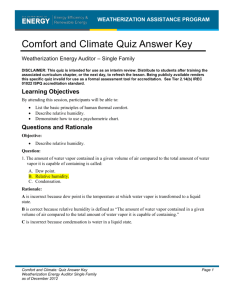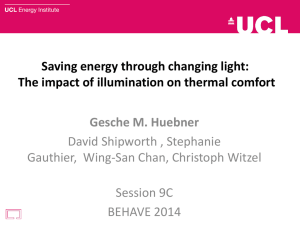ARC-04-3189-Fakoyede..
advertisement

AN ASSIGNMENT ON THERMAL COMFORT CONDITIONSIN A TYPICAL RESIDENTIAL STOREY BUILDING ALONG OBA ADESIDA ROAD, AKURE Submitted by: FAKOYEDE BANKOLE JAMES (ARC/04/3189) Course: APPLIED CLIMATOLOGY [ARC 810] To The Department Of Architecture, Federal University of Technology, Akure In Partial Fulfillment of M. Tech Degree in Architecture Lecturer in Charge: Prof. Ogunsote AUGUST , 2011 ABSTRACT The provision of ventilation air for high-rise multifamily residential housing has plagued retrofit practitioners and researchers alike. Various studies have been carried out on the air flows and ventilation systems in storey buildings in Massachusetts and in California, and have seen all the horror stories of poorly functioning systems that are neither efficient nor deliver satisfactory ventilation. Frequent problems include the imbalance of supply and exhaust air, the lack of an unobstructed path for supply air, differences in ventilation rates between upper and lower floors and a change in air flow due to seasonal variations in temperature and wind. Based on detailed photographic images of poor housing construction which reduces the efficiency of good air flow, we have characterized some common problems and suggest strategies to improve the performance of these systems. For people living in warm humid climate, the perception of comfort is influenced by long-term conditioning to high temperatures and humidity. Clothing and personal habits are influenced by exterior conditions, as are expectations of comfort. A study of occupants of urban housing in Akure indicates tolerance to high temperatures and very high humidities for comfort. Given the climate of the region and little experience of air conditioning this is not unexpected. Building design in urban areas is marked by the increasing popularity of multi-storeyed apartment blocks, where the choice of wall thickness and exposure to radiation can make significant contribution to indoor comfort. Simple means such as cool surfaces and ceiling fans are able to provide comfort. 2 1.0 INTRODUCTION. Comfort is a subjective sensation. It is the state of mind that expresses satisfaction with the thermal environment. Alternatively, it is that state of mind that does not express dissatisfaction with the thermal environment. It’s equivalent to conditions in which human beings can sleep soundly and work comfortably and when there is a minimum demand on the thermo-regulatory mechanisms of the body. Outside comfort exists discomfort, which is characterized by the duration and degree of thermal stress. Comfort within dwellings is achieved partly by protecting buildings from heat gain during the heat periods and by preventing heat loss during cold periods. When mechanical aids are employed for this purpose, they should only supplement passive methods (Ogunsote 1991). The human thermal comfort as defined by ASHRAE is the state of mind that expresses the satisfaction of an individual within his surrounding environment. It is also defined in British Standard BS EN ISO 7730 as: ‘that condition of mind which expresses satisfaction with the thermal environment.’ Maintaining thermal comfort for occupants of buildings or other enclosures is one of the important goals of HVAC design engineers. Thermal comfort is affected by heat conduction, convection, radiation and evaporative heat loss. Thermal comfort is maintained when the heat is generated by human metabolism is allowed to dissipate, thus maintaining thermal equilibrium with the surroundings. Any heat gain or loss beyond this generates a sensation of discomfort. It has long been recognized that the sensation of feeling cold or hot is not just dependent on air temperature alone. 1.1 THE BENEFITS OF THERMAL COMFORT. The benefits of thermal comfort include; Increased occupant comfort. Increased durability of building components. Reduced carbon footprint. Reduced energy cost. Reduced building maintenance. Improved indoor air quality with proper ventilation strategy. 3 To provide good indoor air quality, it is important to know the air flow pattern into and within a building. The air-mass flows and their distribution in a given building are caused by pressure differences evoked by wind, thermal buoyancy, mechanical ventilation systems, or combination of these. But air flow is also influenced by the distribution of openings in the building shell and by the inner pathways. Actions by the occupants can also lead to significant differences in pressure distribution inside a building (see Figure 1). 1.0 THERMAL COMFORT CONDITIONS IN AKURE. Thermal comfort is very important to the comfort many individuals living residential quarters. It can also affect the mental state of residence living in such affected buildings, and in turn affect their performance and productivity of their work and daily activity. Also, thermal discomfort has been known to lead to Sick Building Syndrome symptoms. The combination of high temperature and high relative humidity serves to reduce thermal comfort and indoor air quality. The occurrence of symptoms increased much more with raised indoor temperatures in the winter than in the summer due to the larger difference created between indoor and outdoor temperatures. 4 2.0 FACTORS DETERMINING THE HUMAN THERMAL COMFORT. There are several factors that affect the human comfort. They can be grouped into thus; Personal Factors. (Health, Psychology, Sociology, Situational factors). These could lead to Insulative clothing (Clo Value) and the Activity levels of the individual involved (Met Value). General Factors. These include; Air temperature, Mean Radiant Temperature, Relative Humidity (perspiration), Drifts and Ramps in operative temperature. Localized Factors. These include; Air movement or velocity (wind chill factor), Radiant Asymmetry, Floor surface temperature (under floor heating), Air temperature stratification. The Air temperature, Humidity, Radiation and the air movement are factors of the thermal environment. Other factors that may have some effect on thermal comfort are age, sex, body shape, state of health, ethnic groupings, diet, sleep, colour of clothing, acclimatization, availability of fresh air, transients, colour of space enclosure and noise (EVANS 1980). An indication of the relative importance of these factors aforementioned is that when they are all within an acceptable and optimal range, about 70% of the population will be comfortable. The comfort limits for each of the four environmental factors that determine comfort are discussed below with the assumptions in each case that all the other factors are within Comfort limits. 2.1.1 Air Velocity: - Air Velocity has an important influence on skin temperature, skin wetness, convective and evaporative heat loss, and thermal sensation. This has always been incorporated into thermal comfort standards. There are two recommendations for allowable air velocities in terms of minimizing draft risk and providing desirable occupant cooling. The elimination of draft is addressed by placing rather stringent limits on the allowable mean air speed as a function of air temperature and turbulence intensity (defined as the standard deviation of fluctuating velocities divided by their mean for the measuring period). As an example, the draft risk data (representing 15% dissatisfaction curves) for a turbulence intensity of 40% (typical of indoor office environments) would restrict the mean air speed to 0.12 m/s (24 fpm) at 20°C 68°F) and 0.2 m/s (40 fpm) at 26°C (78.8°F). In warmer climates, such as those frequently found in the U.S., air motion is often considered as highly desirable for both comfort (cool breeze for relief) and air quality (preventing stagnant air) reasons. ASHRAE Standard 55 allows local air velocities to be higher than the low values 5 specified for draft avoidance if the affected occupant has individual control over these velocities. By allowing personal control of the local thermal environment, UFAD systems satisfy the requirements for higher allowable air velocities contained in Standard 55 and have the potential to satisfy all occupants. Wind Velocity. Temperature Mechanical Wind Direction. Differences Ventilation Systems Surroundings Vertical flow Fan and Duct Resisitance characteristics Shape of the Building Wind pressure Thermal distribution. Buoyancy Building Inhabitant behaviour Leakage configuration Inside pressure distribution Air flow Distribution Figure 1: Influence on the Air Flow Distribution in Buildings 6 Imposed pressure 2.1.2 Air Temperature: The air temperature, i.e the dry bulb temperature is a very important factor affecting thermal comfort. When temperatures are low, people feel cold and when they are high, people feel hot. Comfort can approximately be achieved between 16 and 28 degrees Celsius. 2.1.3 The Mean Radiant Temperature: This refers usually to radiation to and from surfaces within an enclosed space measured with the globe thermometer. It calculated using the air temperature and velocity. Comfort can be achieved if the globe temperature is between 16 and 28 degrees Celsius. 2.1.4 Personal Control Factors: One of the greatest potential improvements of UFAD systems over conventional overhead systems is in the area of occupant thermal comfort, in that individual preferences can be accommodated. In today’s work environment, there can be significant variations in individual comfort preferences due to differences in clothing, activity level (metabolic rate), and individual preferences. In terms of clothing variations, if a person reduced their level of clothing from a business suit (0.9 clo) to slacks and a short-sleeved shirt (0.5 clo), the room temperature could be increased by approximately 2°C (4°F) and still maintain equivalent comfort. As an example of the variations in activity level that commonly occur, a person walking continuously around in an office (1.7 met) will experience an effective temperature of the environment that is approximately 2 to 3°C (3 to 5°F) warmer than that for a person sitting quietly at their desk (1.0 met), depending on clothing level. Considering the magnitude of variations described above, a range of control up to 3°C (5°F) is probably enough for most applications. Recent laboratory tests have shown that commercially available fan-powered supply outlets provide personal cooling control of equivalent whole-body temperature over a sizable range: up to 7°C (13°F) of sensible cooling for desktop-mounted outlets and up to 5°C (9°F) of sensible cooling for floor-based outlets. This amount of control is clearly more than enough to allow individual thermal preferences to be accommodated. 7 Figure 2. Whole-body cooling rates, DEHT (°C), for two desktop jet diffusers blowing air toward a person seated in front of desk. Results applicable to average room temperatures of 22-26°C (72-79°F), room-supply temperature differences of 0-7°C (013°F), and supply volumes of 9.4-71 L/s (20-150 cfm). Figure 3. Whole-body cooling rates, DEHT (°C), for fan-powered floor jet diffuser (consisting of four grills mounted in one floor panel) blowing air toward a person seated approximately 1 m (3 ft) to the side. Results applicable to average room temperatures of 22-26°C (72-79°F), room-supply temperature differences of 0-7°C (0-13°F), and supply volumes of 23.6-85 L/s (50-180 cfm). 8 2.1.5 General Factors: - The general factors include the air temperature; the mean radiant temperature; the relative humidity (also perspiration) and drifts and ramps in operative temperature. 2.1.5.1: Operative temperature The ideal standard for thermal comfort can be defined by the operative temperature. This is the average of the air dry-bulb temperature and of the mean radiant temperature at the given place in a room. In addition, there should be low air velocities and no drafts. Little variation in the radiant temperatures from different directions in the room, and humidity within a comfortable range. The operative temperature intervals varied by the type of indoor location. They also vary by the time of the year. For example, a single office in a building has an occupancy ration per Celsius (77.9F), and airflow velocity of 0.18m/s. 2.1.5.2 Relative Humidity The human body has sensors that are fairly efficient in sensing cold, but they are not very effective in detecting relative humidity. Relative humidity creates the perception of an externally dry or extremely damp indoor environment. This can then play a part in the perceived temperature and their thermal comfort. The recommended level of indoor humidity is in the range of 30-60%. A way to measure the amount of relative humidity in the air is to use a system of dry-bulb and wet-bulb thermometers. A dry-bulb thermometer measures the temperature not relative to moisture. This is generally the temperature reading that is used in weather reports. In contrast, a wet-bulb thermometer has a small wet cloth wrapped around the bulb at its base, so the reading on that thermometer takes into account water evaporation in the air. The wet-bulb reading will thus always be at least slightly lower than the dry bulb reading. The difference between these two temperatures can be used to calculate the relative humidity. The larger the temperature differences between the two thermometers, the lower the level of relative humidity. The wettedness of skin in different areas also affects perceived thermal comfort. Humidity can increase wetness on different areas of the body, leading to a perception of discomfort. This is usually localized in different parts of the body and local thermal comfort limits for local skin wettedness differ between different skin locations of the body. The extremities are much more sensitive to thermal discomfort from wetness than the trunk of the body. Although local thermal discomfort can be caused from wetness, the thermal comfort of the whole body will not be affected by the wetness of certain parts. 9 Recently, the effects of low relative humidity and high air velocity were tested on humans after bathing. Researchers found that low relative humidity engendered thermal discomfort as well as the sensation of dryness and itching. It is recommended to keep relative humidity levels higher in a bathroom than other rooms in the house for optimal conditions. 10 3.0 THE CLIMATE OF AKURE. Plate 1. Map showing Akure, the capital of Ondo state. The basic understanding of the climatic conditions and the thermal stress (comfort conditions) in Akure is required to design a good residential apartment. What is required is not only collection and analysis of long term climatic data but also extensive study of the comfort conditions, heat loads and occupant’s personal behavioral pattern during different seasons of the year. During this write-up, some data are being derived from a data chart already prepared showing the average climatic conditions in Akure. From the data available, Akure enjoys a moderate tropical climate with maximum temperature of 33 degrees Celsius and minimum temperatures rarely falling below 20 degrees Celsius. Relative humidity is always moderate with maximum relative 11 humidity at 86% and minimum relative humidity rarely falling below 40%. There is some form of precipitation throughout the year, even though there are distinct wet and dry seasons. There is usually more than six hours of sunshine, even during the rainy season. (Analysis of data collected from weather stations in Akure by Federal University of technology, Akure (FUTA) students). The climate conditions in Akure are characterized by high humidity and hot discomfort for eleven or more months in the year. This makes provision for of permanent ventilation essential. 12 4.0 BUILDING DESCRIPTION. 4.1 CASE STUDY ONE OF A TYPICAL STOREY BUILDING ALONG OBA ADESIDA ROAD, AKURE. Located at No. 4, Bakare Street, off Oba Adesida road, Akure in a busy and densely populated environment, the first residential apartment surveyed is located within the daily activities of commuters and petty traders selling their wares. The structure in is a three storey room-to-room residential apartment inhabiting a number of thirty families. Plate 2: Picture showing the front facade a typical two storey building. Plate 3: Picture showing the poor location of the stairhall to the building directly beside a residents window 13 Plate 4: Hollow block walls being used as fenestration and openings for ventilation into the stair hall. A few of the thermal comfort conditions which are observed in this building are thus; The building, located in the coastal region of Nigeria faces the East-West direction. This is where d longer part of the building is located which therefore makes it less proper for effective ventilation within the spaces in the building as the wind direction is towards the North-West direction. The use of mosquito nettings and Louvre blades are visible on the building. These are opening components which determines the velocity and pattern of air flow in the building.(Fig 1).it also provides privacy as well as regulation of ventilation. The Louvre blades used in the There are absences of window hood materials on the windows which may serve as a good shading device as the sun sets at the west direction which may cause glare to occupants living at the East wing of the building. (Plate 2) Open terraces and verandahs exists on the building serving as a means of ventilation for occupants during the hot humid periods especially when there’s a power outage and there’s no means for mechanical form of ventilation. Here occupants may use the verandah an alternative to receive ventilation as the interior spaces may hot and humid. (Plate 5). Poor location of the stairhall directly beside an occupant’s window causes 14 Plate 5: Picture showing verandah The existing rooms in the building can only boast of a single window located at the exterior of the building. The rooms are constructed on a double bank form where there exists a common passageway. These features causes the rooms to be stuffy and hot as there exists only an opening on one side of the room. The common passageway is usually dark and uncomfortable during the most times of the day. (Plate 6) Plate 6 : Picture showing the rooms in a double bank with a common dark and stuffy passageway. 15 4.2 CASE STUDY TWO OF A TYPICAL STOREY BUILDING ALONG OBA ADESIDA ROAD, AKURE. Case study two is located at 17, Oba Adesida road, Akure. The building is a four bedroom block of flat on a two storey residential apartment inhabiting a number of four families. Each floor has a balcony. The building is exposed on all four sides to the wind Plate 7: Picture showing the front façade of the building. The thermal comfort conditions observed in this building are thus; There exist adjacent windows on all sides of the rooms especially the bedrooms. This is a good arrangement of fenestration as this aids proper ventilation and flow of air. There exists a verandah at each block serving as a means of aiding ventilation especially on hot humid hours of the day where occupants may need more air. It also serves as a great spot for occupants willing to relax and take some fresh air or a spot to for sleeping when the rooms become stuffy and unfit for sleeping during the dry season. (Plate 6). There is visible use of egg crate form of shading device known as the window hood on all the fenestrations on the building. This can be shown in plate 7 below. There also exists a zinc covered shed fabricated below the shading device. This also adds as a shading device and a rainproof material reducing the effect of wind induced rain from entering the space. 16 Plate 8: Shading over windows could reduce the need for energy intensive air-conditioning units. 5.0 CLIMATIC FACTORS OF THE CASE STUDY AREA (AKURE). Akure, being in a hot and humid region in Nigeria, indoor comfort is an important issue mainly in the hot dry season. The modern construction sector of the country was mainly directed to active climatization and that has made the trend to invest heavily in expensive modern building materials which are heat generating sources for inner volumes. 5.0.1 Temperature:- According to the bio climatic charts, Akure area does not have wide variations in The average temperature difference between hottest month and the temperature. coldest month within a year does not exceed 10C. The amplitude between day and night is about 4–8°C. 5.0.2 Relative Humidity:- Relative humidity is always high during the daytime and night the maximum monthly relative humidity is in during January–February and November–December. Maximum and minimum monthly relative humidity always lies in 68–85% ranges. Relative humidity is higher at night than at day (opposite of temperature). 5.0.3 Rainfall:- The monthly rainfall exceeds 200mm for three or more months 17 5.0.4 Solar Radiation and Sunshine:- In every month Akure gets sunshine, more than 6 hours per day and it is more than 8 hours per day from March to September. Therefore the solar radiation is very high in the Ampere area. But because of high humidity, large part of the solar radiation comes as defuse radiation. 5.1 COMFORT CONDITIONS IN AKURE. Researches carried out by Professor Ogunsote & Prucnal-Ogunsote (2003) indicates that the comfort limits and method proposed by Evans (1980) are the most effective for the determination of thermal stress for the Nigerian climate. This method uses the air temperature and the relative humidity to establish the thermal stress. Relative Humidity (%) Figure 4: Day comfort limits Night comfort limits (degree Celsius) (degree Celsius) 0-30 29.5-32.5 27.5-29.5 30-50 28.5-29.5 26.5-29.0 50-70 27.5-29.5 26.0-28.5 70-100 26.0-29.0 25.5-28.0 Comfort Limits produced by Evans (Evans 1980). These limits are used to determine the comfort conditions (thermal stress) in Akure. The day thermal stress was obtained by comparing the mean monthly maximum temperature with the day comfort limits using the mean monthly minimum relative humidity. Note that the maximum temperature is used with the minimum relative humidity because both readings are taken in the early afternoon. The night thermal stress is obtained by comparing the mean monthly minimum temperature with the night comfort limits using the mean monthly maximum relative humidity. 18 6.0 RECOMMENDATIONS ANS CONCLUSION. People employ adaptive strategies to cope with their thermal environment, e.g donning or removing clothing, unconscious changes in posture, choice of heating, moving to cooler locations away from heat sources, etc. The problems arise when this choice (to remove jacket, or move away from heat source) is removed, and people are no longer able to adapt. In many instances the environment within which people work is a product of the processes of the job they are doing, so they are unable to adapt to their environment. To achieve adequate thermal comfort in residential storey buildings in Akure (being a hot humid climate) involves the proper flow of air through buildings resulting to adequate ventilation. The liberty to control the rate of flow of air in the spaces within such residential buildings also gives occupants the regulative control on the intensity of flow of air. This as a result of diverse human temperament and needs which differs from one individual to another. Some factors that affect airflow through buildings are the external factors; number and size of openings; position of openings; and the opening components. (Ogunsote) The presence of verandahs is expected to have a range of effects on a building’s environmental behavior, in terms of aspects of natural ventilation, thermal comfort pollutant transportation and shading and day lighting. The presence of the verandahs can significantly increase the air flow rate of most buildings in a naturally ventilated building. Although the verandah reduces the indoor average velocity for most rooms, it does not change the indoor thermal comfort level. However the presence of a verandah improves comfort by increasing the uniformity of indoor air distribution. 19 7.0 REFERENCES. ASHRAE (2004).Thermal Environmental Conditions for Human Occupancy. Atlanta: America. Society of Heating, Refrigeration and Air-conditioning Engineers. Nicol, F. (2004). Adaptive thermal comfort standards in the hot-humid tropics. Energy and Buildings, 36(7), 628-637. OGUNSOTE O.O, ADEDEJI Y.M.D and ALUKO O.O. Sustainable Landscaping and green housing in tropical climates: A case study of Akure, Nigeria. Federal University of Technology, Akure. HELMUT E. FEUSTEL and RICHARD C. DIAMOND. Air Flow Distribution in a Highrise residential building. Lawrence Berkely National Laboratory, Berkely, U.S.A FAUD H. MALLICK. Thermal Comfort and Building design in the tropical climates. Department of Architecture, Bangladesh University of Engineering and Technology, Dhaka 1000, Bangladesh. MYRHEN J. A., & HOLMBERG, S. (2008). Flow patterns and thermal comfort in a room with panel, floor and wall heating. Energy and Buildings, 40(4), 524-536. OGUNSOTE O.O. Applied Climatology. Thermal Comfort. (Chapter three): Factors affecting thermal comfort. Pg 3-4 20







